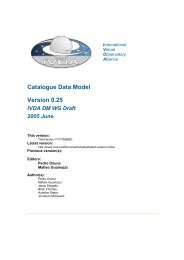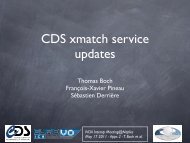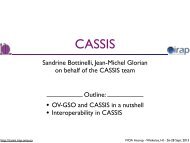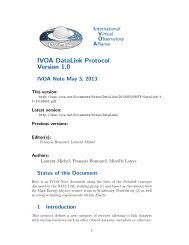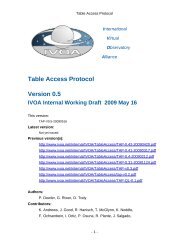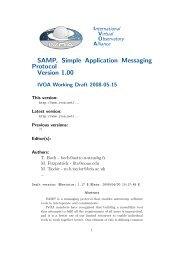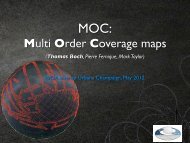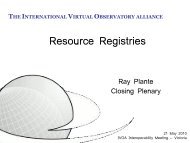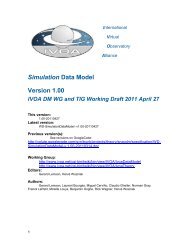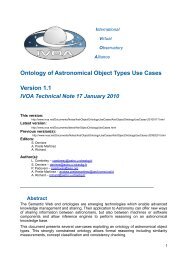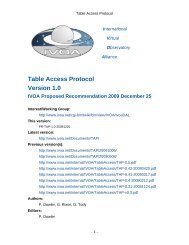SAMP â Simple Application Messag- ing Protocol Version 1.11 - IVOA
SAMP â Simple Application Messag- ing Protocol Version 1.11 - IVOA
SAMP â Simple Application Messag- ing Protocol Version 1.11 - IVOA
Create successful ePaper yourself
Turn your PDF publications into a flip-book with our unique Google optimized e-Paper software.
For each of the named parameters, and each of the returned values, thefollow<strong>ing</strong> information must be provided:• name• data type (map, list or str<strong>ing</strong> as described in Section 3.3) and ifappropriate scalar sub-type (see Section 3.4)• mean<strong>ing</strong>• whether it is OPTIONAL (considered REQUIRED unless stated otherwise)• OPTIONAL parameters MAY specify what default will be used if thevalue is not suppliedTogether, this is much the same information as should be given for documentationof a public interface method in a weakly-typed programm<strong>ing</strong> language.The parameters and return values associated with each MType form extensiblevocabularies as explained in Section 2.6, except that there is noreserved “samp.” namespace.Note that it is possible for the MType to have no returned values. This isactually quite common if the MType does not represent a request for data. Itis not usually necessary to define a status-like return value (success or failure),since this information can be conveyed as the value of the samp.status entryin the call response as described in Section 3.9.5.3 MType Vocabulary: Extensibility and ProcessThe set of MTypes forms an extensible vocabulary along the lines of Section2.6. The relatively small set of MTypes in the “samp.” namespace isdefined in Section 5.4 of this document, but applications will need to usea wider range of MTypes to exchange useful information. Although clientsare formally permitted to define and use any MTypes outside of the reserved“samp.” namespace, for effective interoperability there must be public agreementbetween application authors on this unreserved vocabulary and its semantics.Since addition of new MTypes is expected to be ongo<strong>ing</strong>, MTypes fromthis broader vocabulary will be documented outside of this document toavoid the administrative overhead and delay associated with the <strong>IVOA</strong> RecommendationTrack [8]. At time of writ<strong>ing</strong>, the procedures for maintain<strong>ing</strong>the list of publicly-agreed MTypes are quite informal. These proceduresremain under review, however the current list and details of best practicefor add<strong>ing</strong> to it are, and will remain, available in some form from the URLhttp://www.ivoa.net/samp/.33



